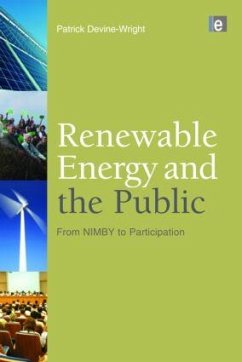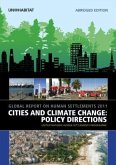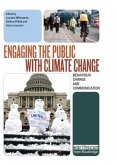Renewable Energy and the Public
From NIMBY to Participation
Herausgeber: Devine-Wright, Patrick
Renewable Energy and the Public
From NIMBY to Participation
Herausgeber: Devine-Wright, Patrick
- Gebundenes Buch
- Merkliste
- Auf die Merkliste
- Bewerten Bewerten
- Teilen
- Produkt teilen
- Produkterinnerung
- Produkterinnerung
First Published in 2010. Routledge is an imprint of Taylor & Francis, an informa company.
Andere Kunden interessierten sich auch für
![Not the End of the World Not the End of the World]() Hannah RitchieNot the End of the World8,99 €
Hannah RitchieNot the End of the World8,99 €![Transitions to Sustainable Development Transitions to Sustainable Development]() John GrinTransitions to Sustainable Development202,99 €
John GrinTransitions to Sustainable Development202,99 €![Cities and Climate Change Cities and Climate Change]() Un-HabitatCities and Climate Change94,99 €
Un-HabitatCities and Climate Change94,99 €![Engaging the Public with Climate Change Engaging the Public with Climate Change]() Engaging the Public with Climate Change202,99 €
Engaging the Public with Climate Change202,99 €![Urban Planning in the Third World Urban Planning in the Third World]() Madhu SarinUrban Planning in the Third World160,99 €
Madhu SarinUrban Planning in the Third World160,99 €![An Economic Sociology of Law Reimagined An Economic Sociology of Law Reimagined]() Clare WilliamsAn Economic Sociology of Law Reimagined180,99 €
Clare WilliamsAn Economic Sociology of Law Reimagined180,99 €![Sustainable Value Creation Sustainable Value Creation]() David ChandlerSustainable Value Creation171,99 €
David ChandlerSustainable Value Creation171,99 €-
-
-
First Published in 2010. Routledge is an imprint of Taylor & Francis, an informa company.
Hinweis: Dieser Artikel kann nur an eine deutsche Lieferadresse ausgeliefert werden.
Hinweis: Dieser Artikel kann nur an eine deutsche Lieferadresse ausgeliefert werden.
Produktdetails
- Produktdetails
- Verlag: Taylor & Francis
- Seitenzahl: 368
- Erscheinungstermin: 3. November 2010
- Englisch
- Abmessung: 242mm x 164mm x 35mm
- Gewicht: 705g
- ISBN-13: 9781844078639
- ISBN-10: 1844078639
- Artikelnr.: 29834210
- Herstellerkennzeichnung
- Produktsicherheitsverantwortliche/r
- Europaallee 1
- 36244 Bad Hersfeld
- gpsr@libri.de
- Verlag: Taylor & Francis
- Seitenzahl: 368
- Erscheinungstermin: 3. November 2010
- Englisch
- Abmessung: 242mm x 164mm x 35mm
- Gewicht: 705g
- ISBN-13: 9781844078639
- ISBN-10: 1844078639
- Artikelnr.: 29834210
- Herstellerkennzeichnung
- Produktsicherheitsverantwortliche/r
- Europaallee 1
- 36244 Bad Hersfeld
- gpsr@libri.de
Prof. Devine-Wright researches social and psychological aspects of new energy infrastructure such as wind farms, drawing on the concepts of place attachment and place identity to explain 'NIMBY' responses. He is based at the University of Exeter, UK.
Introduction (Patrick Devine-Wright, University of Exeter, UK)
Section 1: Conceptual approaches
1. Symmetries, expectations, dynamics and contexts: a framework for
understanding public engagement with renewable energy projects (Walker,
University of Lancaster, UK, and colleagues)
2. The principles, procedures, and pitfalls of public engagement in
decision-making about renewable energy (Haggett, University of Edinburgh,
UK)
3. Beyond consensus? Agonism, republicanism and a low carbon future (Barry
and Ellis, Queens' University, Belfast, N. Ireland)
4. Public roles and socio-technical configurations: diversity in renewable
energy deployment in the UK and its implications (Walker and Cass,
University of Lancaster, UK)
5. From Backyards to Places: Public engagement and the emplacement of
renewable energy technologies (Patrick Devine-Wright, University of Exeter,
UK)
Section 2: Empirical studies of public engagement
Part 1: Stakeholder and media representations of public engagement
6. Discourses on the implementation of wind power: Stakeholder views on
public engagement (Wolsink, University of Amsterdam, Netherlands)
7. Governing the Reconfiguration of Energy in Greater London: Practical
Public Engagement as 'Delivery' (Hodson and Marvin, University of Salford,
UK)
8. Envisioning public engagement with renewable energy: an empirical
analysis of images within the UK National Press 2006/7 (Hannah
Devine-Wright, University of Manchester, UK)
9. NIMBYism and community consultation in electricity transmission network
planning (Cotton and Patrick Devine-Wright, University of Exeter, UK)
Part 2: Case studies of public beliefs and responses
Future energy scenarios
10. Turning the heat on: Public engagement in Australia's energy future
(Ashworth, Littleboy, Graham & Niemeyer, Commonwealth Scientific and
Industrial Research Organisation, Australia)
Solar energy and microgeneration
11. Shaping people's engagement with microgeneration technology: the case
of solar photovoltaics in UK homes (Abi-Ghanem, Imperial College London and
Haggett, University of Edinburgh, UK)
12. Siting Solar Power in Arizona: A Public Value Failure? (Pasqualetti and
Schwartz, Arizona State University, USA)
13. Socio-Environmental Research on Energy Sustainable Communities:
Participation Experiences of Two Decades (Schweizer-Ries, University of
Saarland, Germany)
14. Yes in my back yard: UK householders pioneering microgeneration heat
(Roy and Caird and Roy, Open University, UK)
Wind energy
15. Socio-environmental impacts of Brazil's first large-scale wind farm
(Improta and Pinheiro, Federal University of Rio Grande do Norte, Natal,
Brazil)
16. Perceptions and Preferences Regarding Offshore Wind Power in the United
States - The Leading Edge of a New Energy Source for the Americas
(Firestone, University of Delaware, USA)
Hydrogen energy:
17. The limits of upstream engagement in an emergent technology: lay
perceptions of hydrogen energy technologies (Flynn, Bellaby and Ricci,
University of Salford, UK)
18. Public engagement with wind-hydrogen energy technology: a comparative
study (Sherry-Brennan, Devine-Wright and Devine-Wright, University of
Exeter, UK)
Marine energy
19. Symbolic interpretations of wave energy in the UK: surfers'
perspectives (McLachlan, University of Manchester, UK)
Bioenergy
20. Heat and light: understanding bioenergy siting controversy (Upham,
University of Manchester, UK)
Nuclear and low carbon energy
21. From the Material to the Imagined: Public Engagement with Low Carbon
Technologies in a Nuclear Community (Butler, Parkhill and Pidgeon, Cardiff
University, Wales, UK)
Conclusions (Devine-Wright, University of Exeter, UK)
Section 1: Conceptual approaches
1. Symmetries, expectations, dynamics and contexts: a framework for
understanding public engagement with renewable energy projects (Walker,
University of Lancaster, UK, and colleagues)
2. The principles, procedures, and pitfalls of public engagement in
decision-making about renewable energy (Haggett, University of Edinburgh,
UK)
3. Beyond consensus? Agonism, republicanism and a low carbon future (Barry
and Ellis, Queens' University, Belfast, N. Ireland)
4. Public roles and socio-technical configurations: diversity in renewable
energy deployment in the UK and its implications (Walker and Cass,
University of Lancaster, UK)
5. From Backyards to Places: Public engagement and the emplacement of
renewable energy technologies (Patrick Devine-Wright, University of Exeter,
UK)
Section 2: Empirical studies of public engagement
Part 1: Stakeholder and media representations of public engagement
6. Discourses on the implementation of wind power: Stakeholder views on
public engagement (Wolsink, University of Amsterdam, Netherlands)
7. Governing the Reconfiguration of Energy in Greater London: Practical
Public Engagement as 'Delivery' (Hodson and Marvin, University of Salford,
UK)
8. Envisioning public engagement with renewable energy: an empirical
analysis of images within the UK National Press 2006/7 (Hannah
Devine-Wright, University of Manchester, UK)
9. NIMBYism and community consultation in electricity transmission network
planning (Cotton and Patrick Devine-Wright, University of Exeter, UK)
Part 2: Case studies of public beliefs and responses
Future energy scenarios
10. Turning the heat on: Public engagement in Australia's energy future
(Ashworth, Littleboy, Graham & Niemeyer, Commonwealth Scientific and
Industrial Research Organisation, Australia)
Solar energy and microgeneration
11. Shaping people's engagement with microgeneration technology: the case
of solar photovoltaics in UK homes (Abi-Ghanem, Imperial College London and
Haggett, University of Edinburgh, UK)
12. Siting Solar Power in Arizona: A Public Value Failure? (Pasqualetti and
Schwartz, Arizona State University, USA)
13. Socio-Environmental Research on Energy Sustainable Communities:
Participation Experiences of Two Decades (Schweizer-Ries, University of
Saarland, Germany)
14. Yes in my back yard: UK householders pioneering microgeneration heat
(Roy and Caird and Roy, Open University, UK)
Wind energy
15. Socio-environmental impacts of Brazil's first large-scale wind farm
(Improta and Pinheiro, Federal University of Rio Grande do Norte, Natal,
Brazil)
16. Perceptions and Preferences Regarding Offshore Wind Power in the United
States - The Leading Edge of a New Energy Source for the Americas
(Firestone, University of Delaware, USA)
Hydrogen energy:
17. The limits of upstream engagement in an emergent technology: lay
perceptions of hydrogen energy technologies (Flynn, Bellaby and Ricci,
University of Salford, UK)
18. Public engagement with wind-hydrogen energy technology: a comparative
study (Sherry-Brennan, Devine-Wright and Devine-Wright, University of
Exeter, UK)
Marine energy
19. Symbolic interpretations of wave energy in the UK: surfers'
perspectives (McLachlan, University of Manchester, UK)
Bioenergy
20. Heat and light: understanding bioenergy siting controversy (Upham,
University of Manchester, UK)
Nuclear and low carbon energy
21. From the Material to the Imagined: Public Engagement with Low Carbon
Technologies in a Nuclear Community (Butler, Parkhill and Pidgeon, Cardiff
University, Wales, UK)
Conclusions (Devine-Wright, University of Exeter, UK)
Introduction (Patrick Devine-Wright, University of Exeter, UK)
Section 1: Conceptual approaches
1. Symmetries, expectations, dynamics and contexts: a framework for
understanding public engagement with renewable energy projects (Walker,
University of Lancaster, UK, and colleagues)
2. The principles, procedures, and pitfalls of public engagement in
decision-making about renewable energy (Haggett, University of Edinburgh,
UK)
3. Beyond consensus? Agonism, republicanism and a low carbon future (Barry
and Ellis, Queens' University, Belfast, N. Ireland)
4. Public roles and socio-technical configurations: diversity in renewable
energy deployment in the UK and its implications (Walker and Cass,
University of Lancaster, UK)
5. From Backyards to Places: Public engagement and the emplacement of
renewable energy technologies (Patrick Devine-Wright, University of Exeter,
UK)
Section 2: Empirical studies of public engagement
Part 1: Stakeholder and media representations of public engagement
6. Discourses on the implementation of wind power: Stakeholder views on
public engagement (Wolsink, University of Amsterdam, Netherlands)
7. Governing the Reconfiguration of Energy in Greater London: Practical
Public Engagement as 'Delivery' (Hodson and Marvin, University of Salford,
UK)
8. Envisioning public engagement with renewable energy: an empirical
analysis of images within the UK National Press 2006/7 (Hannah
Devine-Wright, University of Manchester, UK)
9. NIMBYism and community consultation in electricity transmission network
planning (Cotton and Patrick Devine-Wright, University of Exeter, UK)
Part 2: Case studies of public beliefs and responses
Future energy scenarios
10. Turning the heat on: Public engagement in Australia's energy future
(Ashworth, Littleboy, Graham & Niemeyer, Commonwealth Scientific and
Industrial Research Organisation, Australia)
Solar energy and microgeneration
11. Shaping people's engagement with microgeneration technology: the case
of solar photovoltaics in UK homes (Abi-Ghanem, Imperial College London and
Haggett, University of Edinburgh, UK)
12. Siting Solar Power in Arizona: A Public Value Failure? (Pasqualetti and
Schwartz, Arizona State University, USA)
13. Socio-Environmental Research on Energy Sustainable Communities:
Participation Experiences of Two Decades (Schweizer-Ries, University of
Saarland, Germany)
14. Yes in my back yard: UK householders pioneering microgeneration heat
(Roy and Caird and Roy, Open University, UK)
Wind energy
15. Socio-environmental impacts of Brazil's first large-scale wind farm
(Improta and Pinheiro, Federal University of Rio Grande do Norte, Natal,
Brazil)
16. Perceptions and Preferences Regarding Offshore Wind Power in the United
States - The Leading Edge of a New Energy Source for the Americas
(Firestone, University of Delaware, USA)
Hydrogen energy:
17. The limits of upstream engagement in an emergent technology: lay
perceptions of hydrogen energy technologies (Flynn, Bellaby and Ricci,
University of Salford, UK)
18. Public engagement with wind-hydrogen energy technology: a comparative
study (Sherry-Brennan, Devine-Wright and Devine-Wright, University of
Exeter, UK)
Marine energy
19. Symbolic interpretations of wave energy in the UK: surfers'
perspectives (McLachlan, University of Manchester, UK)
Bioenergy
20. Heat and light: understanding bioenergy siting controversy (Upham,
University of Manchester, UK)
Nuclear and low carbon energy
21. From the Material to the Imagined: Public Engagement with Low Carbon
Technologies in a Nuclear Community (Butler, Parkhill and Pidgeon, Cardiff
University, Wales, UK)
Conclusions (Devine-Wright, University of Exeter, UK)
Section 1: Conceptual approaches
1. Symmetries, expectations, dynamics and contexts: a framework for
understanding public engagement with renewable energy projects (Walker,
University of Lancaster, UK, and colleagues)
2. The principles, procedures, and pitfalls of public engagement in
decision-making about renewable energy (Haggett, University of Edinburgh,
UK)
3. Beyond consensus? Agonism, republicanism and a low carbon future (Barry
and Ellis, Queens' University, Belfast, N. Ireland)
4. Public roles and socio-technical configurations: diversity in renewable
energy deployment in the UK and its implications (Walker and Cass,
University of Lancaster, UK)
5. From Backyards to Places: Public engagement and the emplacement of
renewable energy technologies (Patrick Devine-Wright, University of Exeter,
UK)
Section 2: Empirical studies of public engagement
Part 1: Stakeholder and media representations of public engagement
6. Discourses on the implementation of wind power: Stakeholder views on
public engagement (Wolsink, University of Amsterdam, Netherlands)
7. Governing the Reconfiguration of Energy in Greater London: Practical
Public Engagement as 'Delivery' (Hodson and Marvin, University of Salford,
UK)
8. Envisioning public engagement with renewable energy: an empirical
analysis of images within the UK National Press 2006/7 (Hannah
Devine-Wright, University of Manchester, UK)
9. NIMBYism and community consultation in electricity transmission network
planning (Cotton and Patrick Devine-Wright, University of Exeter, UK)
Part 2: Case studies of public beliefs and responses
Future energy scenarios
10. Turning the heat on: Public engagement in Australia's energy future
(Ashworth, Littleboy, Graham & Niemeyer, Commonwealth Scientific and
Industrial Research Organisation, Australia)
Solar energy and microgeneration
11. Shaping people's engagement with microgeneration technology: the case
of solar photovoltaics in UK homes (Abi-Ghanem, Imperial College London and
Haggett, University of Edinburgh, UK)
12. Siting Solar Power in Arizona: A Public Value Failure? (Pasqualetti and
Schwartz, Arizona State University, USA)
13. Socio-Environmental Research on Energy Sustainable Communities:
Participation Experiences of Two Decades (Schweizer-Ries, University of
Saarland, Germany)
14. Yes in my back yard: UK householders pioneering microgeneration heat
(Roy and Caird and Roy, Open University, UK)
Wind energy
15. Socio-environmental impacts of Brazil's first large-scale wind farm
(Improta and Pinheiro, Federal University of Rio Grande do Norte, Natal,
Brazil)
16. Perceptions and Preferences Regarding Offshore Wind Power in the United
States - The Leading Edge of a New Energy Source for the Americas
(Firestone, University of Delaware, USA)
Hydrogen energy:
17. The limits of upstream engagement in an emergent technology: lay
perceptions of hydrogen energy technologies (Flynn, Bellaby and Ricci,
University of Salford, UK)
18. Public engagement with wind-hydrogen energy technology: a comparative
study (Sherry-Brennan, Devine-Wright and Devine-Wright, University of
Exeter, UK)
Marine energy
19. Symbolic interpretations of wave energy in the UK: surfers'
perspectives (McLachlan, University of Manchester, UK)
Bioenergy
20. Heat and light: understanding bioenergy siting controversy (Upham,
University of Manchester, UK)
Nuclear and low carbon energy
21. From the Material to the Imagined: Public Engagement with Low Carbon
Technologies in a Nuclear Community (Butler, Parkhill and Pidgeon, Cardiff
University, Wales, UK)
Conclusions (Devine-Wright, University of Exeter, UK)








